As I was standing in Revolution Square in Havana, Cuba, looking at the giant silhouette of Che Guevara, I smiled, recalling the Che Guevara Café I once visited in Beirut where I watched a male belly dancer as I was reporting on Lebanon’s first LGBT organization. It occurred to me that the relationship between the United States and the Middle East is easy to explain compared to the relationship our country has with Cuba, as well as Cuba’s position on LGBT issues.
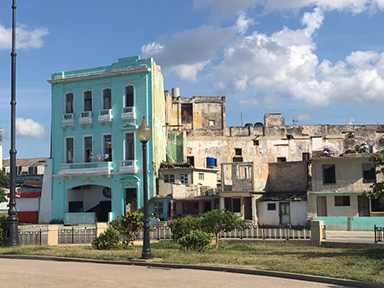
It was 20 years ago when I reported on the state of LGBT life in Havana. The difference could not be more apparent than it was in the procedure to arrange my travel to Cuba. In 1997, as an out LGBT journalist — and refusing to be anything but out — I received no assistance from the U.S. government, except the warning that I could have trouble re-entering the United States, since the U.S. government might not recognize LGBT reporters as legitimate journalists. As for Cuba, its embassy refused to return calls. It was almost a clandestine trip. I had to travel via Mexico and arrange hotel and other necessities through third- and fourth-party connections. At times, it was cloak and dagger.
And there was reason for Cuban hesitance in having an LGBT journalist in the country: Life for LGBT people at that time was like 1950s America, or worse. (Read more about that trip at http://bit.ly/2q46XUQ.) Twenty years would bring some surprises and a brush with the past, both in the United States and Cuba.
Modern U.S. travel protocol made the arrangements slightly easier than 20 years ago. The Cuban Embassy not only sped up my visa, they arranged for me to have official Cuban press credentials, which they also did for other U.S. LGBT media on the same trip. This is an amazing fact that should not be overlooked, as it makes the point clear that Cuba is attempting — with baby steps — to open its society and go after the lucrative worldwide LGBT tourism market.
The timing could not have been better, since Cuba was about to commemorate the 10th-annual International Day Against Homophobia and Transphobia, spearheaded in the country by the Cuban National Center for Sex Education. CENESEX is headed by Mariela Castro, the daughter of the current president of Cuba and niece to its former president, Fidel Castro.
My first evening’s dinner proved that Cuba had changed — but at the same time is even more complex. That dinner was spent with old friend and U.S. LGBT pioneer the Rev. Troy Perry of Metropolitan Community Church, who was scheduled to receive an award from CENESEX. We dined with members of his Cuban church, headed by Elaine Saralegui, an out lesbian from Matanzas, Cuba. Their work begins to explain the story of the culture of the Cuban people and how change occurs. It’s an eye-opener for many in our country since when we speak of socialist/communist Cuba, many often think of a godless society, but indeed the last three popes have made it a point to visit Cuba. Now, about 40 percent of Cubans identify as Catholic while others follow the African Caribbean Santería faith.
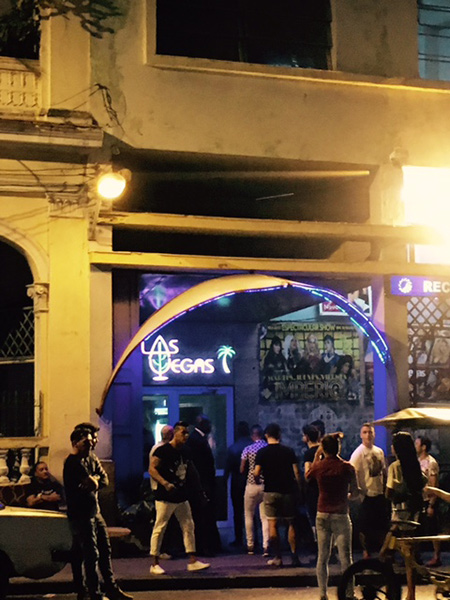
In order to understand Cuba and Cubans, you must know that religion is a large part of their culture, and religious views on the LGBT community are intertwined with the country’s politics. Example: As the country opens its doors even further, U.S. fundamentalists are looking for influence and to apostolize. A story that’s making the rounds is that American fundamentalists offered to bring in a million Bibles and the Cuban religion minister (yes, they have a religion minister) stated, “Let the U.S. end the embargo and we’ll buy our own Bibles.”
Things have changed. But faith and that embargo influence almost all aspects of Cuba today, as its youth look to the future with a skeptical eye. But Perry’s church has a distinction. It is the first official non-government LGBT organization in Cuba, a distinction that has plagued individuals who have tried to organize independent LGBT organizations. Perry takes pride in stating that Cuba now becomes the 34th nation with MCC churches.
“We even have one in Kuala Lumpur,” he noted.
Perry’s Cuban church was conceived when he visited the island two years ago as an invited speaker for a religious conference. A local Baptist church was sponsoring a small LGBT meeting group, but after those in attendance heard Perry and his story about the battle to form MCC in the United States, and how his faith community is LGBT-inclusive, they asked and received permission to form MCC Cuba.
The distinctions and progress don’t end there. Perry tells me that the Catholic Church in Cuba imports its priests from other Latin countries and that all MCCs will have Cuban-born ministers.
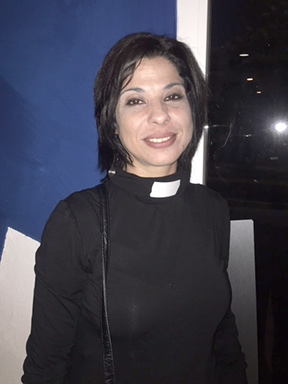
The first is Saralegui, making her the first independent out lesbian activist in Cuba who tells me with a grin that she identifies as an LGBT Christian activist. She’s one of those individuals who was in the audience two years ago when Perry spoke and said that “God is my pastor and he knows I’m gay.” Saralegui, who was in the seminary at the time studying to be a minister for Cuba’s Baptist Church, was inspired by the address and asked her bishop about creating a church for LGBT people. A few disagreements later, MCC Matanzas (a city that considers itself Cuba’s art capital) became Cuba’s first out Church.
When she’s not tending to her own church, which varies between 20-40 members, Saralegui travels the country performing liturgies for LGBT Cubans and anyone else who wants to hear her message of inclusion.
“I want our community to be proud,” she says with a smile through a translator. Saralegui has already tackled some major issues. A week ago, her church held a service officiated by three international transgender ministers: from Brazil, Canada and the United States. When I ask her if she’s had any issues from members of the LGBT community about her activism, she smiles broadly and states, “Some don’t believe you can be Christian and gay.”
If you bring up the issues of trans people in Cuba, people will reference CENESEX and its program to support gender-reassignment surgery. They’ll proudly point to Clinico Quirurgico, a government-run hospital that specializes in such operations, and explain that like all medical needs in Cuba it’s free, and like most things in Cuba, you can’t get exact numbers.
Cuba’s past often clashes with its present. The convoluted connections and disconnections when you attempt to explain how open or repressed the LGBT community in Cuba can be is displayed by looking at a part of its shameful past — then realizing it’s something that is very present in the United States.


Meet Louis. Now 74, he survived one of Cuba’s labor camps for gay men in the 1960s. When you ask him what it was like when, at 16, he was taken to a camp, he smiles and says, “Everyone in my neighborhood said I was that way.” If you ask him how bad it was, he’ll tell you that “the second day they yelled and yelled at me, ‘Be a man, be a man.’ All day.” And when asked if they ever physically harmed him, he says, “They never hit those of us in the camps; they only spoke at us.” On most days, the men had to sit through what today we’d call re-programming. “They had signs everywhere: ‘The revolution needs men.’ And they kept telling us we had to be men and gay people were not men.” When I ask what it was like each day, he tells me that, aside from listening to the psychologist camp officials brought in from Havana, the men were put to work. I try to ask him about the harshness of that work but fail and he notices, smiles and shakes his head.
According to Louis, there were many camps and each had about 120 men in it. No physical harm, but hard work that allegedly attempted to make you a hard (read: real) man. The government used to attempt to deny it ever had such camps but before his death, Fidel Castro admitted it and apologized. Louis, a short, jovial man, wanted a personal apology and he eventually received it from another Castro: CENESEX’s Mariela.
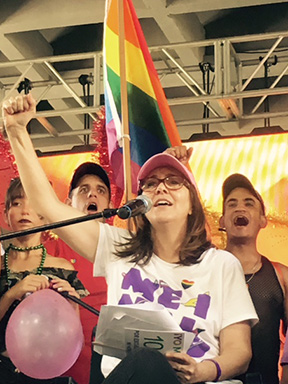
Louis is not clear on how he left the camp but he’s clear about what he did afterward.
“My old life was no more and I couldn’t go home or get work so I went to the capital [Havana],” he recalled. “I told them I lost my papers and was given new papers; they never knew about my past life.”
He studied and became a technical draftsman. He found love, and settled into life. When I ask what he thinks the future holds for Cuba’s LGBT community, he shrugs and says he’s “hopeful.” And you can see he wants people not to forget their history, but he doesn’t want that connection to the past to impede progress. It’s a hard line he walks, but he does it with a joyous style. It amazed me a couple days later as I watched him dancing at the CENESEX rally, doing a rhumba with his friends. Louis was enjoying life and its new freedoms, but never letting go of the papers that recall his time in the labor camp.
Americans, especially LGBT Americans, use the camps as a hammer against Cuba, but while Cuba has moved on, the U.S. still has its equivalent: conversion-therapy camps. And some of those camps do hand out corporeal punishment. As to numbers, Louis tells me that several-thousand gay inmates were housed in a section of Cuba far from Havana. In the U.S, conversion therapy is still flourishing and is associated with that word again: religion. If you don’t get the theme, think about Uganda and its “Kill the Gays” legislation. Again, it’s fundamentalism.
The reality is that you can’t judge Cuba on its treatment of LGBT people in the past. Louis wants to live for today, and in today’s Cuba, at least for the LGBT community, things have changed. It’s not all about weekend dance parties that are now all the rage with the LGBT community.
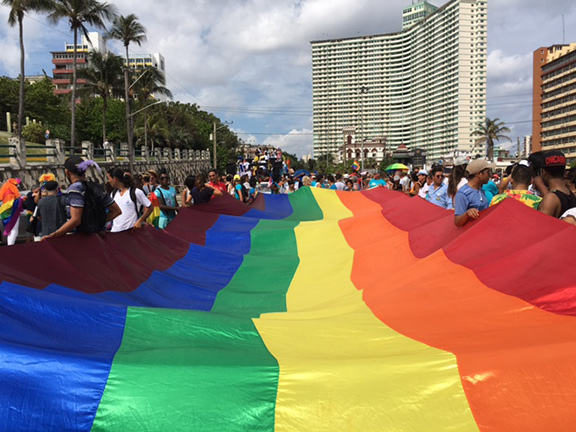
My tour guide, Leandro Velazco, states about LGBT tourism: “We have bars, nightly ‘inclusion’ parties, a couple of good restaurants, a state-run LGBT organization, occasional festivals and even Grindr.” When I look quizzically at him, he tells me about something called Planet Romeo, which he said was the first LGBT social-networking site to hit Cuba several years ago. His business, GaytoursHavana.com, like many in Cuba, is adjusting to the ’Net, hoping that the promise of LGBT tourism in Cuba becomes a reality.
Before leaving for Cuba, it was handy to google Amnesty International to see what it had on Cuban repression. The background states: “The re-establishment of relations between the USA and Cuba in 2015 led to increased trade and tourism between the two countries in 2016. For example, commercial air services from the USA to Cuba resumed after more than 50 years.” You can read the full report at www.amnesty.org/en/countries/americas/cuba/report-cuba/#.
So where’s the repression? Each time I asked someone to name a famous LGBT person, they all said the same. They’d mention a name and say, “We know, but they keep it to themselves.”
I thought of that as I marched in the International Day Against Homophobia and Transphobia rally, along with almost 1,000 Cubans. They shouted socialist slogans peppered with “End Homophobia and Transphobia Now.” There were no corporate sponsors, which reminded me of our first gay Pride in the United States, and indeed this looked more like a gay Pride celebration than a march of defiance. At the rally, there were a few speeches and then a dance and festival. CENESEX used the time and event for HIV education, condom distribution and testing.
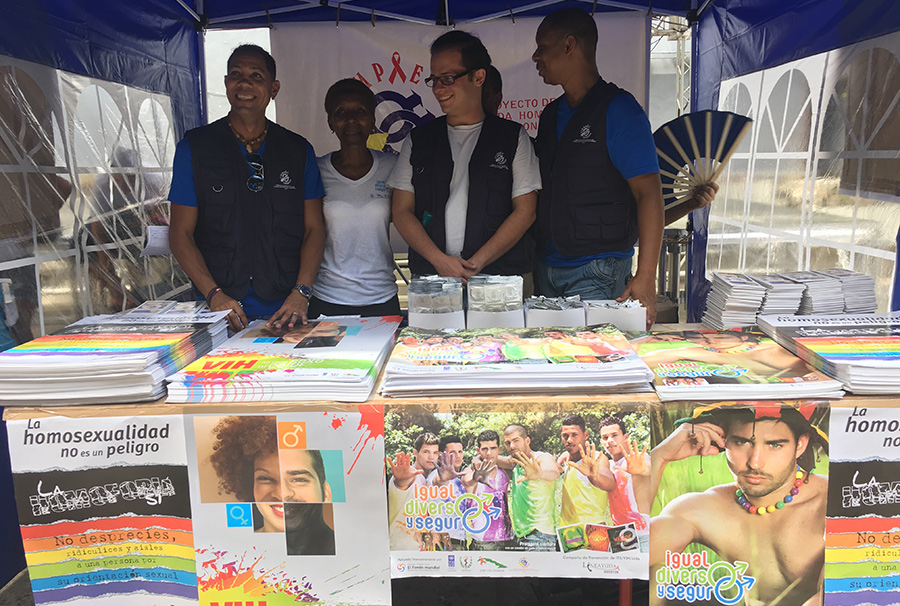
Once you work out the political dissertation, you can then try and unravel the country’s views on LGBT tourism. There’s no question that Cuba wants to get in the game. There are at least four LGBT tour-guide sites on the web and numerous individuals and travel groups in the United States who specialize in LGBT tourism to Cuba. And surrounding the 10th-annual International Day Against Homophobia and Transphobia, the government gave official press credentials to several LGBT media outlets. So Cuba is open. How open, and to what kind of travel?
Cuba is home to great weather, beaches, mountains, incredible colonial architecture and some of the most hospitable people you’ll ever meet, but at times due to that touchy subject of the U.S. embargo — which some claim is keeping this country in economic turmoil while others say it is the government’s political repression that stifles Cuba — it seems the country is in a time capsule. That can be a curse or a charm. The old U.S. Buicks and Chevys are an example. They’re charming but their prevalence points out that new cars are at a premium — although that has begun to change, as has the hospitality industry, which languished for years. On the way to the airport, you notice parking lots full of new taxis and tour buses waiting for the explosion of tourists.
Cubans call their country “The Pearl of the Caribbean,” but that pearl is trapped by the U.S. embargo, which wreaks havoc on tourism. There is not one place in all of Cuba that you can use an American credit card. Therefore, cash is a requirement. How many Americans want to travel with a wad of cash in their pockets?
There is no way to write about Cuba and not elicit strong views on one side or the other. What I can say after speaking with Cubans themselves is that they want change and they don’t want to be the pawns among governments.

